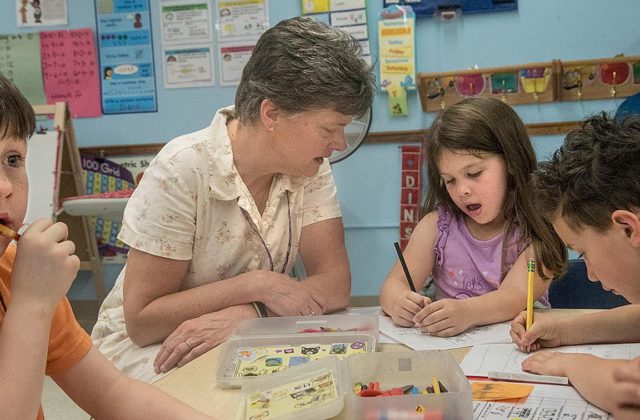One Year in, Multiage Classrooms at Botelle Judged a Success
Program will expand next year
By Jude Mead
Botelle Elementary School implemented its first multiage classroom this past year, combining the kindergarten and first grade classes. Faced with the prospect of declining enrollment, Principal Lauren Valentino, along with teachers Bea Tirrell and Deb Tallon, revitalized an educational model that dates back centuries to the one-room school house. This contemporary take, however, is not just a matter of practicality. According to Valentino, “Multiage classrooms create a more positive educational experience and provide benefits for teachers, students and families.” The successful year-end evaluation of the program proved her right.
Most people are familiar with the more traditional model of the teacher-centered classroom where children are divided into appropriate age-level grades and are expected to reach certain benchmarks by year’s end in order to move on. The multiage classroom is more student-centered. Students learn in an environment that encourages cooperation and hands-on learning, one that provides more personalized instruction while reinforcing good social growth. “It is a more balanced classroom, that allows all students time to develop their academic skills as well as their social and emotional strengths,” said Valentino.

Deb Tallon with her multiage class of kindergartners and first graders. Bea Tirrell, top, with members of her class.
Careful planning went into the curriculum used by Tirrell and Tallon in their classrooms. Tirrell said they worked together last summer reviewing kindergarten, first grade and second grade curriculum to craft lesson plans that fit the pilot program. “We looked at standards and expectations at all three grade levels. We also took into consideration the individual needs of each student and how she or he would learn best,” said Tirrell. The teachers split the students into two groups of ten and eleven and focused on establishing whole-class and individual learning goals. Tallon added that many instructional modalities such as auditory, visual, and kinesthetic are incorporated into the program. “Kids learn differently and at different rates. In our classrooms we take this into consideration and are able to adjust accordingly,” she said.
In a multiage education children who are academically advanced or those who need extra time to master the material can easily take part in any of the skill levels offered while maintaining interactions with peers. “In this way multiage education provides a sense of competence to all students,” said Valentino. Having the same teacher for two years also helps. “Because we have the same kids for two years we get to know them and follow their development. Then we can plan for the year ahead and jump right into teaching,” said Tallon. Valentino added that next September will be less stressful because teachers will have a clear idea where they left off with each student, and students will feel more secure knowing they will be returning to the same teacher and classmates. “They will also have more background knowledge and previous learning,” she said.
Tirrell stressed the social benefits. “I think the greatest gain is social. It helps all kids socially and gives them more options to interact with one another,” she said. Role modeling is especially important. Whether because of proper behavior in the classroom or because older students are helping younger students learn, the cognitive development and self-esteem of both younger and older students improve, according to Tirrell.
As with any program, there are also challenges. Knowing the full range of expectations for all the participating grades is demanding for teachers, said Valentino, who would like to give teachers more training time to learn about the different grade curriculums. Tallon found that setting up an effective math program to teach her students good number sense took some consideration and time. “The reading and writing seems to come more easily when planning. Math is a bit more difficult when there is a wider range of levels, “she said.
Parents are important to the multiage classroom said Valentino. “They are supportive and enthusiastic about their children’s progress. The children go home happy and excited about learning,” she said. Hilary Fitzgibbons, the mother of a kindergartener in the program, agrees that her daughter finds school interesting and is thrilled about reading. “She is exposed to better vocabulary and already knows 70 percent of the first grade vocabulary. She enjoys going off to school each day and always has something to share when she comes home,” Fitzgibbons said.
Catie Dougan, mother of a first grader, had her concerns when she initially heard about a multiage setting at Botelle. She could not understand how a teacher could teach a five-year-old and a seven-year-old together. “It was a new concept for me, but I wanted to go in with an open mind,” said Dougan. Her views changed after observing her daughter’s classroom and watching her blossom throughout the year. “I went from not knowing what to expect to falling in love with multiage classrooms,” she said.
Botelle’s first year of multiage classrooms appears to have had powerful results. It is more than a group of different-aged children placed in a classroom. It is a well-organized and well-thought-out program to optimize learning within a cooperative atmosphere. Valentino already has plans for next year, when Botelle will also combine pre-K and kindergarten students. This year’s kindergarten and first grade students will movine into a combined first and second grade. Valentino, Tallon and Tirrell all agreed that the students at Botelle are lucky, as the school puts the students at the front and center of learning.
Photos by Bruce Frisch.

